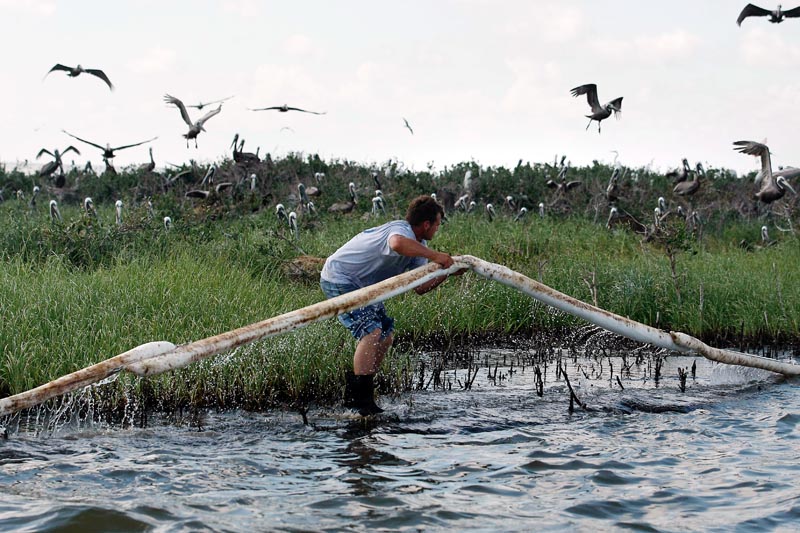COVINGTON, La. — The dire impact of the massive Gulf spill was apparent Sunday on oil-soaked islands where pelicans nest as several of the birds splashed in the water and preened themselves, apparently trying to clean crude from their feet and wings.
Pelican eggs were glazed with rust-colored gunk in the bird colony, with thick globs floating on top of the water. Nests sat precariously close to the mess in mangrove trees. As oil crept farther into the delicate wetlands in Barataria Bay off Louisiana, BP officials said Sunday that one of their efforts to slow the leak wasn’t working as effectively as before.
BP spokesman John Curry said that a mile-long tube inserted into the leaking well siphoned some 57,120 gallons of oil within the past 24 hours, a sharp drop from the 92,400 gallons of oil a day that the device was sucking up Friday. However, the company has said the amount of oil siphoned will vary widely from day to day.
Engineers are working furiously to stem the growing ooze as more wildlife and delicate coastal wetlands are tainted despite the oil-absorbing booms placed around shorelines to protect them.
Meanwhile, three top Obama administration officials are returning to the Gulf Coast to monitor the spill response.
Environmental Protection Agency chief Lisa P. Jackson was headed Sunday to Louisiana, where she planned to visit with frustrated residents.
Secretary of the Interior Ken Salazar and Secretary of Homeland Security Janet Napolitano were to lead a Senate delegation to the region today to fly over affected areas and keep an eye on the response.
White House Press Secretary Robert Gibbs told CBS’ “Face the Nation” on Sunday that Justice Department officials have been to the region gathering information about the spill. However, he wouldn’t say whether the department has opened a criminal investigation.
President Obama also has named a special independent commission to review what happened. The spill began after the Deepwater Horizon oil rig exploded off the coast of Louisiana on April 20, killing 11 workers, and sank two days later. At least 6 million gallons of crude have spewed into the Gulf of Mexico since, although a growing number of scientists have said they believe it’s more.
The visits from top Obama chiefs come as BP said it will be at least Tuesday before engineers can shoot mud into the blown-out well at the bottom of the Gulf, yet another delay in the effort to stop the oil.
A so-called “top kill” has been tried on land but never 5,000 feet underwater, so scientists and engineers have spent the past week preparing and taking measurements to make sure it will stop the oil that has been spewing into the sea for a month. They originally hoped to try it as early as this weekend.
“It’s taking time to get everything set up,” BP spokesman Tom Mueller said. “They’re taking their time. It’s never been done before. We’ve got to make sure everything is right.”
Crews will shoot heavy mud into a crippled piece of equipment atop the well. Then engineers will direct cement at the well to permanently stop the oil.
BP has failed several times to halt the gusher, and has had some success with the mile-long tube. Engineers also are developing several other plans in case the top kill doesn’t work.
Copy the Story LinkSend questions/comments to the editors.



Success. Please wait for the page to reload. If the page does not reload within 5 seconds, please refresh the page.
Enter your email and password to access comments.
Hi, to comment on stories you must . This profile is in addition to your subscription and website login.
Already have a commenting profile? .
Invalid username/password.
Please check your email to confirm and complete your registration.
Only subscribers are eligible to post comments. Please subscribe or login first for digital access. Here’s why.
Use the form below to reset your password. When you've submitted your account email, we will send an email with a reset code.